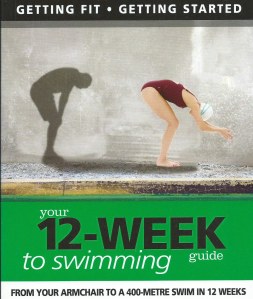Swimming
Taking care of the details

WEEK 9
It’s time to refine your swimming technique…
The best way to get better at something is to do it. This is why earlier in the programme we urged you to swim, swim and swim some more. At the start it was simply about getting back in the water and shaking off that swimming rustiness. Then it was about slowly building up your fitness and learning to enjoy exercising again. Now is a good time for you to review your technique in a bit more detail. A good technique leads to smoother swimming, meaning you will travel further in the water with less effort. Now that can’t be bad can it?
Earlier in the book we recommended you use the breaststroke as you train towards your end goal. Although clearly not the fastest stroke, it is probably the most comfortable for the majority of people who have been away from swimming for a lengthy period. To make it more efficient concentrate getting your arms and legs to work together. It’s easy if you have strong legs to let them dominate the movement of the upper body and vice versa, so always work on getting the correct timing between these two components to get the maximum benefit from each stroke.
Keep your body as flat as possible in the water and don’t let your hips and legs ‘sink and drag’, although accept that as you lift your head to take a breath your body position will shift a bit. Avoid looking up, which will strain your neck, and instead keep your eyes looking down and forwards. This will also help you avoid your legs ‘sinking and dragging’, which effectively causes resistance and will slow you down, making your whole swim harder tougher.
On each stroke, stretch out as if you are trying to reach something in front of you, and use the palms of your hands like flippers to really push the water away, then turn them down and inwards as they come back through the stroke. Make sure you bring your feet up towards your backside and not underneath your body. Again, this is important, as pulling your feet up underneath your body will cause resistance and slow you down. Don’t be afraid to really push your legs for extra propulsion rather than just going through the motions, but avoid breaking the water as this will reduce the power that is generated from your legs.
Breathe as you start to pull into each stroke, and work on fine-tuning your timing so you move from your body being fully stretched out to coiled like a frog ready for the pull of the next stroke. If you lose your rhythm, which is easy to do, especially when you get tired, just slow down to regain your composure and slowly get back into your stroke again.
If your preferred stroke is front crawl you will be getting a lot more bang for your bucks, especially if you can maintain your technique, but this is going to be very difficult over the full 400 metres. To be efficient you need to breath only on every second stroke at least, and a lack of air can make it difficult it you are an inexperienced swimmer or just getting back into the sport after a break. However, you may decide to alternate strokes and use front crawl for certain periods.
Concentrate on keeping your body in a streamlined position, and when breathing keep your head movement smooth to maintain this efficient position, rather than ‘snatching’ it sideways as you gulp for air. As one arm enters the water, the other one should be pulling round through the water to continue the circular movement. Turning your hips and shoulders will assist in this movement. Meanwhile, your legs should be kicking away at a steady pace and there should be minimal knee flexion.
If you use backstroke, keep your eyes facing to the ceiling and your ears at the surface. Keep your head still and turn your shoulders and hips, which will allow your arms to come over for each stroke. Use an alternating leg kick and try to keep your chest and shoulders high in the water.